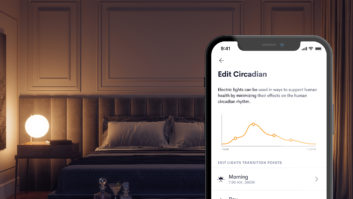NEW YORK — New home-automation initiatives by Apple and the Nest-led Thread Group will raise consumer awareness of home-automation technology and boost demand, but the additional standards could further fragment the market, competitors and marketers warn.
Additional fragmentation would lead to more SKU proliferation at retail and higher manufacturing and distribution costs, they said.
Fragmentation already exists because multiple wireless standards are already in use, including Z-Wave, Wi-Fi, standard and proprietary implementations of ZigBee, and proprietary standards such as Smart Home’s Insteon and Lutron’s Clear Connect. Suppliers offer multi-standard control hubs to unify mobile-device control of products incorporating incompatible wireless technologies, but many retailers still carry multiple SKUs of the same basic door lock or thermostat, said ZWave Alliance chairman Mark Walters.
Fragmentation “creates costs all across the ecosystem,” he said, “and it’s tough for the end user to know if he’s getting the right [product].”
Kevin Meagher, VP/general manager of Lowe’s smart-home division, is concerned about further fragmentation. “Creating new wireless standards is likely to create more problems than it solves, and the news that both Apple and Google are backing different standards is not good for the market,” he contended.
Lowe’s offers its house-brand open-platform Iris control hub, which incorporates multiple open and proprietary wireless standards to communicate with a wide variety of home-automation products, he said. As a result, “we have no vested interests in promoting one technology over another,” but “we need to focus on the consumer and deliver simple, affordable and scalable solutions. This means device vendors need to open their APIs so consumers can choose which service providers and apps they want to use.”
Open APIs, he said, “are more important to market growth than new wireless standards that can be used to lock API access down.”
The ZigBee Alliance and Z-Wave Alliance, which back competing standards, are also concerned.
Z-Wave’s Walters is most concerned about Thread’s potential to fragment the market. “Will [Nest owner] Google dictate how Thread goes to market, or will this be a more open standard?” Walters asked. “Right now it looks like Google will create its own ecosystem,” he said. “Google has big bucks, so it could sway manufacturers to join [its ecosystem].”
Thread could become a closed ecosystem, he explained, because Thread is only a partial standard. Thread defines a 2.4GHz mesh-network radio and communications- level standard, but the technology doesn’t specify an applications layer to carry out commands. The application layer is left up to individual suppliers.
One of those suppliers is Nest, which could devise its own communications protocol and turn Thread into more of a closed standard for use with its smart thermostat, which already uses a form of Thread. “I think Google will use its own communications protocol to create a licensed ecosystem,” Walters said.
In this scenario, Nest’s Wi-Fi-equipped thermostat would accept Wi-Fi commands from mobile devices and computers and send the commands on to connected products over the wireless Thread network.
If Google creates a licensed ecosystem, “Device manufactures might think they have to support [Thread] in addition to the incumbents Z-Wave and ZigBee,” Walters said. “That could complicate inventory and raise manufacturing and consumer costs.”
Thread Group members consist of Nest Labs, Yale Security, Samsung’s CE group and Big Ass Fans, and Thread plans to enlist additional suppliers. The association’s president is Nest’s technical product marketing manager.
The ZigBee Association sees the potential for fragmentation in both the Thread and Apple initiatives. Apple teamed up with LED-lightbulb maker Cree, Kwikset, Schlage, Osram/Sylvania lighting, Honeywell, Haier, Philips, Broadcom and others to develop certified products.
The Apple HomeKit and Thread initiatives “provide well-documented tools that let developers create for the smart-home market,” but “these are still not open standards, and this has implications,” the alliance said. “Developers will have to develop multiple solutions, one for Apple, one for Google.”
The Apple and Thread initiatives “are evidence that the smart home is here today,” but “with the ever-increasing availability and adoption of smart-home products, we believe that in the long term, open global standards will become the preferred option,” the alliance concluded.
Z-Wave’s Walters is less certain that fragmentation will be caused by Apple’s initiative.
“Unlike Thread, [Apple’s] HomeKit is open to multiple [wireless] communications technologies, including ZWave, Bluetooth and [Lutron’s] Clear Connect,” Walters told TWICE. All that Apple is doing “is creating an Appleguaranteed user experience uniform across all technologies and products.” Only Apple-certified devices, however, would appear in, and be controlled from, Apple’s home-control app and Siri voice-control feature.
As a result, Apple’s program might not stimulate SKU proliferation because “it is perfectly conceivable that a HomeKit-compliant device [such as a light dimmer] would also be fully interoperable with another Z-Wave controller such as a Lowe’s Iris [multi-standard] hub,” said Walters. Likewise, a single multi-standard control hub could be devised to talk to Apple’s HomeKit app and to the hub maker’s own iOS and Android apps. Existing home-automation products might need only a firmware upgrade to become Apple-compliant, he said.
Separate SKUs of the same product, however, can’t be completely ruled out if a hardware change is needed to meet Apple’s feature requirements. A supplier could “build and license products specifically for that program [HomeKit], and the products could be different from their products [for] the Staples or Lowe’s Iris hubs,” Walters said. A light dimmer, for example, might be required to offer such features as “go to a specific brightness,” he explained.
Suppliers might also be driven to build two flavors of the same product because of Apple’s licensing costs and the length of Apple’s certification process, marketers said.
Whatever the Apple and Thread initiatives’ impact on retailers and suppliers, “consumers are largely unaware of the many different standards vying for position in the smart home,” said Parks Associates research director Tom Kerber. “While standards are important to the industry, right now only 19 percent of consumers believe that a specific network technology is an important consideration.”












